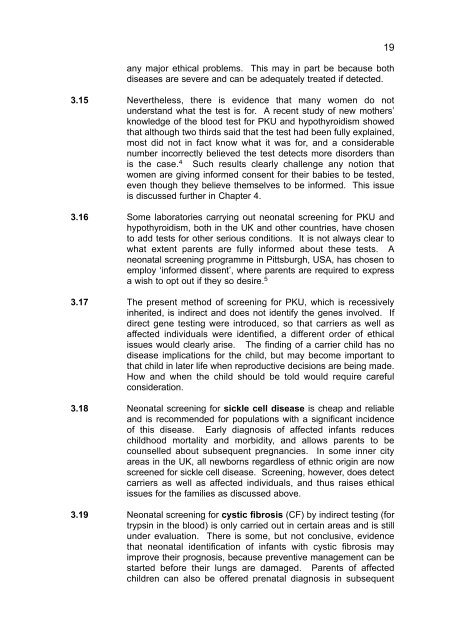Genetic screening: ethical issues - Nuffield Council on Bioethics
Genetic screening: ethical issues - Nuffield Council on Bioethics
Genetic screening: ethical issues - Nuffield Council on Bioethics
Create successful ePaper yourself
Turn your PDF publications into a flip-book with our unique Google optimized e-Paper software.
any major <str<strong>on</strong>g>ethical</str<strong>on</strong>g> problems. This may in part be because both<br />
diseases are severe and can be adequately treated if detected.<br />
3.15 Nevertheless, there is evidence that many women do not<br />
understand what the test is for. A recent study of new mothers’<br />
knowledge of the blood test for PKU and hypothyroidism showed<br />
that although two thirds said that the test had been fully explained,<br />
most did not in fact know what it was for, and a c<strong>on</strong>siderable<br />
number incorrectly believed the test detects more disorders than<br />
is the case. 4 Such results clearly challenge any noti<strong>on</strong> that<br />
women are giving informed c<strong>on</strong>sent for their babies to be tested,<br />
even though they believe themselves to be informed. This issue<br />
is discussed further in Chapter 4.<br />
3.16 Some laboratories carrying out ne<strong>on</strong>atal <str<strong>on</strong>g>screening</str<strong>on</strong>g> for PKU and<br />
hypothyroidism, both in the UK and other countries, have chosen<br />
to add tests for other serious c<strong>on</strong>diti<strong>on</strong>s. It is not always clear to<br />
what extent parents are fully informed about these tests. A<br />
ne<strong>on</strong>atal <str<strong>on</strong>g>screening</str<strong>on</strong>g> programme in Pittsburgh, USA, has chosen to<br />
employ ‘informed dissent’, where parents are required to express<br />
a wish to opt out if they so desire. 5<br />
3.17 The present method of <str<strong>on</strong>g>screening</str<strong>on</strong>g> for PKU, which is recessively<br />
inherited, is indirect and does not identify the genes involved. If<br />
direct gene testing were introduced, so that carriers as well as<br />
affected individuals were identified, a different order of <str<strong>on</strong>g>ethical</str<strong>on</strong>g><br />
<str<strong>on</strong>g>issues</str<strong>on</strong>g> would clearly arise. The finding of a carrier child has no<br />
disease implicati<strong>on</strong>s for the child, but may become important to<br />
that child in later life when reproductive decisi<strong>on</strong>s are being made.<br />
How and when the child should be told would require careful<br />
c<strong>on</strong>siderati<strong>on</strong>.<br />
3.18 Ne<strong>on</strong>atal <str<strong>on</strong>g>screening</str<strong>on</strong>g> for sickle cell disease is cheap and reliable<br />
and is recommended for populati<strong>on</strong>s with a significant incidence<br />
of this disease. Early diagnosis of affected infants reduces<br />
childhood mortality and morbidity, and allows parents to be<br />
counselled about subsequent pregnancies. In some inner city<br />
areas in the UK, all newborns regardless of ethnic origin are now<br />
screened for sickle cell disease. Screening, however, does detect<br />
carriers as well as affected individuals, and thus raises <str<strong>on</strong>g>ethical</str<strong>on</strong>g><br />
<str<strong>on</strong>g>issues</str<strong>on</strong>g> for the families as discussed above.<br />
3.19 Ne<strong>on</strong>atal <str<strong>on</strong>g>screening</str<strong>on</strong>g> for cystic fibrosis (CF) by indirect testing (for<br />
trypsin in the blood) is <strong>on</strong>ly carried out in certain areas and is still<br />
under evaluati<strong>on</strong>. There is some, but not c<strong>on</strong>clusive, evidence<br />
that ne<strong>on</strong>atal identificati<strong>on</strong> of infants with cystic fibrosis may<br />
improve their prognosis, because preventive management can be<br />
started before their lungs are damaged. Parents of affected<br />
children can also be offered prenatal diagnosis in subsequent<br />
19
















